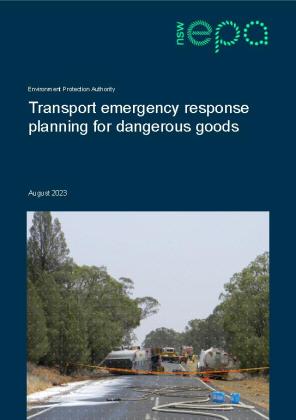Preparing for transport incidents
Anyone who consigns a placard load of dangerous goods, and anyone who transports a placard load of dangerous goods must have a written emergency plan in place prior to undertaking the transport.
This written plan must consider:
- the types and quantities of dangerous goods being transported
- the locations the dangerous goods will be transported
- the types of incidents that may occur during the transport of the dangerous goods
- the personnel and resources required to manage incidents involving the dangerous goods
- procedures to follow to manage incidents involving the dangerous goods.
To support the dangerous goods transport industry to prepare for incidents, the EPA has prepared the Transport Emergency Response Planning for Dangerous Goods document. This document provides detailed information on when emergency plans are required, how to prepare a plan, and how to implement plans when an incident occurs. To support transporters, a set of templates have been prepared which can be used, targeted at transporters with relatively simple operations.
- Guidance: Transport emergency response planning for dangerous goods (PDF 1MB)
- Templates: TERPs guidance templates (DOCX 107KB)
Reporting dangerous goods transport incidents
Any transport incident in NSW involving dangerous goods that results in a dangerous situation must be reported to the emergency services (by calling ‘000’) and the NSW EPA. The DG Regulation defines a dangerous situation as:
a situation that is causing, or is likely to cause, imminent risk of serious injury to a person, significant harm to the environment or significant damage to property.
This report must be made by the prime contractor as soon as practicable, but no more than 1 hour after becoming aware of the incident.
There are penalties for failing to report a dangerous goods incident that results in a dangerous situation.
The EPA is preparing guidance to more clearly define a dangerous situation, but if you are unsure if an incident is a dangerous situation or not, you should assume that it is and report it. There are no penalties for reporting an incident that is later determined to not be a dangerous situation.
Drivers reporting incidents
Drivers must be provided with instruction and training to report incidents involving dangerous goods to the emergency services and the prime contractor for the dangerous goods. Drivers do not need to report an incident to the NSW EPA, unless they are also the prime contractor.
How do I report an incident?
Call 131 555 and tell the operator that you want “to report a dangerous goods transport incident”. They will get the details of the incident that you have available, and contact details so you can be contacted as needed.
Within 21 days of the incident, you will need to provide a written incident report to the EPA. Contact hazardous.materials@epa.nsw.gov.au for more information on what needs to be included in the report.


